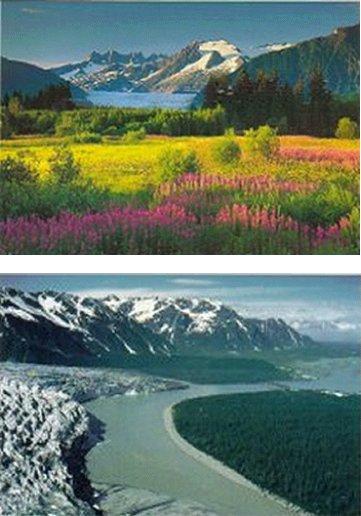 |
Many people, especially in Japan, imagine Alaska is always covered in snow. Actually, Alaska has four distinct seasons including SUMMER! 
The tops of the mountains have a little snow all year round. The alpine slopes, valleys, basins, and river deltas, however, turn a vivid green. Cordova has no shortage of water - heavy rain, melting snow fields, and glaciers all provide water for the lush summer vegetation.
TOP: Sheridan Glacier is one of hundreds of glaciers on the southern coast of Alaska. Blue glaciers nest in green valleys, almost always with a lake or river in front that flows through the delta out to the ocean. The flowers in this picture are known as "Fireweed". These flowers grow in abundance throughout Alaska and Canada. Bees busily pollenate the flowers in early summer. By fall, the flowers are finished, but the flowers turn to white puffy cotton in order to carry the seeds in the autumn winds. Sheridan glacier is only 15 miles from the town of Cordova. This picture was taken from the Copper River Highway, the one and only highway in Cordova.
BOTTOM: The Copper River Highway leaves the town of Cordova and goes 50 miles across the Copper River Delta to Childs and Miles Glacier. The Copper River is named for the copper mining industry that existed North of this photo about 100 years ago. The bridge in this picture was built for a train that carried copper from the interior of Alaska to the port of Cordova at the turn of the last century. Childs Glacier, left, is one of Cordova's most amazing sights. The glacier is constantly rumbling, creaking, popping and growning. Huge pieces of ice break off of the glacier and splash into the Copper River below, sending waves across the river and often washing salmon up on the river banks on the opposite side. The bears like that part!
Why does the river look so muddy? - Because the glaciers are constantly moving and scraping their way through the mountains - this produces silt, fine sand particles, that wash down the rivers and out to the sea.
|  |

